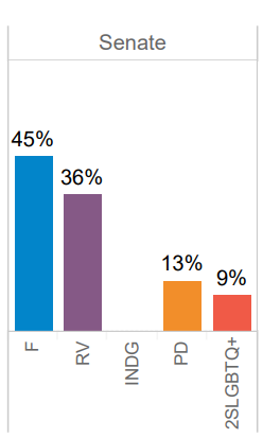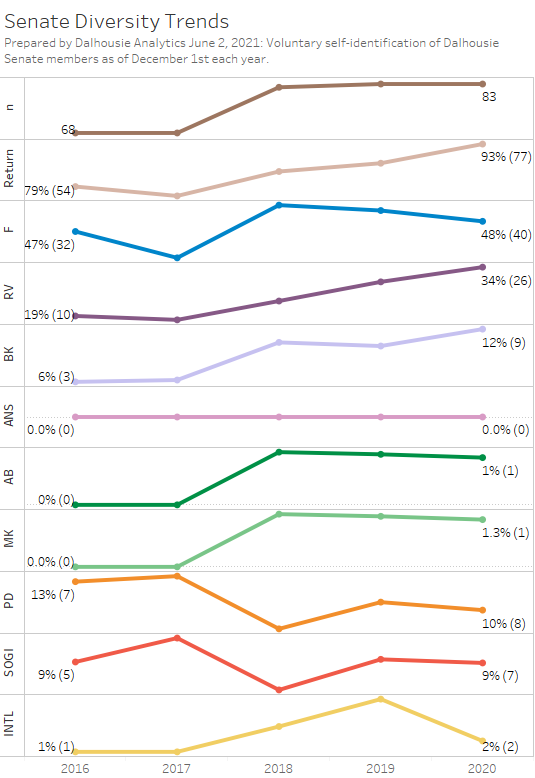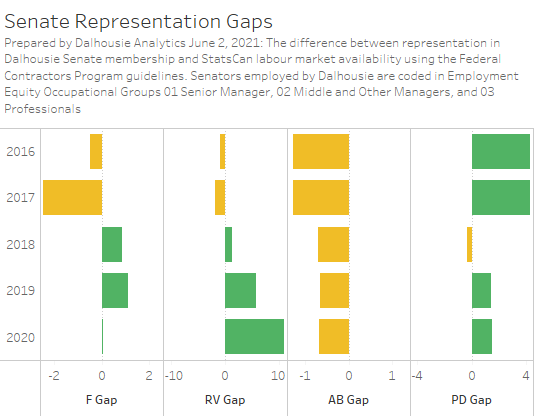Working toward a more inclusive Senate
We are working collaboratively with faculty, senior leaders, and students to reform the membership of the Senate to make it more diverse, inclusive, and representative of the Dalhousie community.
To achieve our goal of a more inclusive Senate, we have undertaken initiatives in the following areas:
Principles, policies, and procedures
- Developed Principles of Diversity, Equity and Inclusion
- Incorporated Diversity, Equity, and Inclusion principles into:
- Created goals and systems to measure and track our progress and identify opportunities for improvement.
Membership
- Approved changes to our membership (effective in 2018-2019) to make it more inclusive by adding:
- Four additional student seats
- Two designated seats for faculty selected by the Black Faculty and Staff Caucus and the Indigenous Council
- Two designated seats for Senators at Large
- Updated our Election Guidelines for Academic Unit Senators to require nominees to describe how they will bring diverse perspectives, identities, and ideas to bear in their roles as Senators.
- Made the university advisor and AVP equity and inclusion ex-officio voting members, along with the AVP academic and VP student affairs.
Community outreach and engagement
- Hosted the Senate Forum on Equity, Diversity and Inclusion on November 13, 2019. Over 200 Dalhousie community members attended to discuss equity, diversity, and inclusion in the classroom and beyond.
- Read more about the Senate Forum on Equity, Diversity and Inclusion in Dal News
- Watch the forum videos on YouTube:
Principles of Equity, Diversity, and Inclusion
June 12, 2017 Approved by Senate
The Senate Planning and Governance Committee is responsible for, among other things:
a) Recommending to Senate representatives to serve on the Board of Governors, the Budget Advisory Committee, and the Search and Review Committees for the President and Vice‐Presidents;
b) Appointing on behalf of Senate representatives on other University‐related committees where Senate representation is required;
c) Reviewing and approving on behalf of Senate significant changes in the governance of Faculties, Schools, Colleges, and Libraries.
d) Reviewing and approving on behalf of Senate significant changes in the governance of academic and research Institutes and Centres;
Senate has embarked on a process of incorporating Diversity, Equity and Inclusion (D,E&I) principles into its governance, practices and processes, in support of the Goal 4 ((b)Integrating diversity and inclusion goals into systems, structures, policies and practices and (c) Regularly monitoring and assessing diversity and inclusiveness performance metrics) of the framework set for the university under Strategic priority 5.2. In particular, D,E&I principles have been incorporated into the Senate constitution and are being incorporated into Senate Faculty and Institute/Centre Reviews, and the practice of populating any committee within the purview of Senate jurisdiction.
We are incorporating D, E & I into the Standing committee Terms of Reference and working to finalize a Senate membership that is diverse and adherent to principles of inclusion and equity. In relation to the responsibilities of the Senate Planning and Governance Committee outlined above, direction is being provided as follows:
The health of our university and success of its mission requires talent from the broadest demographic pool. As a Faculty/School/College/Library leader committed to diversity, equity and inclusion as university principles and priorities, Senate expects you to promote the participation of members of equity seeking groups by
incorporating these principles and priorities into your Faculty/School/College/Library governance documents; and
undertaking inclusive and equitable practices leading to the proposal of a diverse list of nominees whenever representatives are sought by Senate
Given the large gaps in our Federal Contractors Program (FCP) representation, there may be a consequential burden placed on the faculty available to diversify these committees. Recognizing that committees vary in terms of time commitments required and influence in the shaping of the university, members of equity-seeking groups are to be included strategically to maximize their influence. In this way, the university can benefit from their insight and leadership, while minimizing their potential added workload, allowing them to successfully fulfill the requirements of their academic position. Moreover, appropriate support should be provided to those who may be overloaded with other important commitments.
Senate expects Faculty/School/College/Library leaders to report annually on these efforts as outlined in goal 4.8 of the 5.2 Framework: Regularly share progress and publish reports on various diversity/inclusiveness initiatives and outcomes; through appropriate institutional channels under our Diversity and Inclusion Framework.
[i]1 Members of “equity-seeking groups” are persons who experience barriers in employment. According to the Federal Contractors Program under the Employment Equity Act, groups requiring active measures to be implemented to redress historical and present-day disadvantage in employment include: Aboriginal peoples, racially visible persons, women, and persons with disabilities (visible and invisible). As a Federal Contractor, Dalhousie is bound by the terms of this Program with respect to these groups, as amended. At Dalhousie, special consideration will be given to Mi’kmaq peoples and historical African Nova Scotians. Dalhousie also recognizes that individuals who identify as lesbian, gay, bisexual, transgender, and/or queer (LGBTQ) or members of sexual orientation and/or gender identity (SOGI) minority groups experience persistent social and institutional discrimination and marginalization, that manifest as barriers to employment. As such LGBTQ/SOGI members of the Dalhousie community are treated as equity-seeking groups.
Progress and reporting
By developing goals and systems to measure and track progress on equity, diversity, and inclusion (EDI) metrics, we have closed gaps across all equity-seeking groups over the last four years. While progress has been made, we acknowledge that there is still work to do, and we are committed to identifying and acting on opportunities for improvement.
Senate Diversity Profile
Our EDI metrics track the composition of the Senate using the following categories:
- Female (F)
- Racially Visible (RV)
- Indigenous (INDG)
- Persons with a Disability (PD)
- Two-spirit, Lesbian, Gay, Bisexual, Trans, Queer+ (2SLGBTQ+)
All metrics are prepared using the Federal Contractors Program (FCP) Workforce Analysis Methods. [PDF 181 kB]
View the Senate Diversity Profile 2016 – 2020 [PDF 71 kB]
The chart below is the composition of the Senate from 2021 (see the Dalhousie Census Report 2021 for further information). [PDF 596 KB]
 Senate composition as of December 1, 2021
Senate composition as of December 1, 2021
Senate Diversity Trends
Prepared by Dalhousie Analytics June 2021. Based on voluntary self-identification of senate members as of December 1st each year.

Legend for the chart above:
- F Female
- RV Racialized Persons
- INDG Indigenous Peoples
- PD Persons with Disabilities
- SOGI Sexual Orientation and Gender Identity minorities
- BK Black/African
- ANS African Nova Scotian
- MK Mi'kmaq
- Exp Expected Labour Market Availability
- UTR Utilization Rate (progress to fill gap)
Senate Representation Gaps
Prepared by Dalhousie Analytics June 2, 2021. The difference between representation in Dalhousie Senate membership and StatsCan labour market availablility using the Federal Contractors program guidelines. Senators employed by Dalhousie are coded in Employment Equity Occupational Groups 01 Senior Manager; 02 Middle and other managers; and 03 Professionals.

Legend for the chart above:
- F Female
- RV Racialized Persons
- AB Indigenous Peoples
- PD Persons with Disabilities